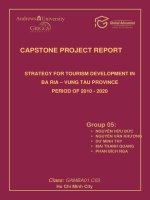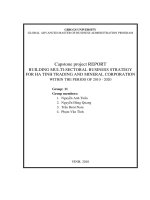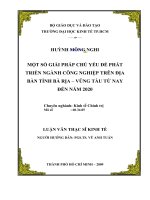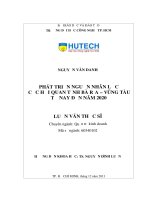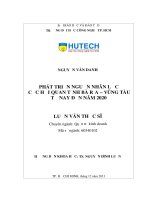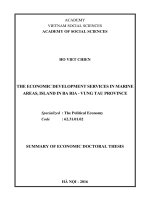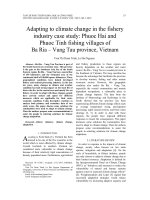Strategy for tourism development in Ba Ria - Vung Tau province period of 2010 - 2020
Bạn đang xem bản rút gọn của tài liệu. Xem và tải ngay bản đầy đủ của tài liệu tại đây (1.06 MB, 60 trang )
STRATEGY FOR TOURISM DEVELOPMENT IN
BA RIA – VUNG TAU PROVINCE
PERIOD OF 2010 - 2020
CAPSTONE PROJECT REPORT
Ho Chi Minh City
Group 05:
NGUYỄN HỮU ĐỨC
NGUYỄN VĂN KHƯƠNG
DƯ MINH THY
MAI THANH QUANG
PHAN BÍCH NGA
Class: GAMBA01.C03
i
CONTENTS
Contents i
Acknowledgments iv
Abbreviations v
List of data sheets v
List of charts v
General introduction 1
Chapter 1 : THEORETICAL BASIS 2
1.1/ Theories of strategy management 2
1.1.1/ Definition of strategy management 2
1.1.2/ Basis of strategy management 3
1.1.3/ Factors for strategy management and decision making 3
1.1.4/ Introduction of matrixes for building strategy 4
1.2/ Definitions of tourism 5
1.2.1/ Definitions of tourism 5
1.2.2/ Tourism classification 6
1.2.3/ Tourism products 6
1.2.3.1/ Definition 6
1.2.3.2/ Characteristics of tourism product 6
1.2.4/ Tourism resources 7
1.2.4.1/ Definition 7
1.2.4.2/ Characteristics of tourism resource 7
1.2.5/ Sustainable tourism 8
1.3/ The studied and applied theories about tourism development strategy 8
1.3.1/ Role of tourism in the economic – social development 8
1.3.2/ The necessity of development strategy management of BR-VT’s tourism
in the period of 2010 – 2020 8
ii
Chapter2:SITUATIONAL ANALYSIS OF BARIA-VUNGTAU’S TOURISM10
2.1/ Overview about BR-VT’s tourism 10
2.1.1/ Features of Ba Ria – Vung Tau 10
2.1.1.1/ Natural features 10
2.1.1.2/ Economic features 11
2.1.2/ Situation of tourism resource planning and exploitation 15
2.1.2.1/ Natural resources 15
2.1.2.2/ Humanitarian resources 16
2.1.2.3/ Unexploited tourism resources 16
2.1.3/ Situation of tourism infrastructure 17
2.1.3.1/ Traffics 17
2.1.3.2/ Electricity, water, telecommunication, environmental sanitation 18
2.2/ Situation and output of BR-VT’s tourism in the previous years 19
2.2.1/ Ba Ria – Vung Tau’s tourism market 19
2.2.1.1/ International visitor market 19
2.2.1.2/ Domestic tourist market 20
2.2.2./ Revenue of tourism sector 21
2.2.3/ Total products of tourism 22
2.2.4/ Material facility of tourism 22
2.2.4.1/ Transporting means 22
2.2.4.2/ Accommodation facility 23
2.2.4.3/ Restaurant service 23
2.2.4.4/ Entertainment and visiting facilities 23
2.2.4.5/ Goods and souvenir 24
2.2.5/ Tourism operation network 24
2.2.6/ Travelling operation 24
2.3/ The scientific basis for researching, solutions to develop BR-VT’s tourism
in 2010-2020 25
2.3.1/ Research background 25
iii
2.3.2/ Research objective, scope, and method 26
2.3.3/ Theoretical basis serving research for tourism 27
2.3.3.1/ Strategy management 27
2.3.3.2/ Comprehensive quality management 29
2.4/ / Limitations, shortcoming in tourism development strategy of BR-VT in
recent years (2010 backwards) 29
2.5/ Causes for limitation, shortcoming in tourism development strategy of
Ba Ria – Vung Tau in the past 29
2.5.1/ Objective causes 29
2.5.2/ Subjective causes 29
Chapter 3 : SOLUTIONS,RECOMMENDATIONS AND CONCLUSION 30
3.1/ Evaluating Ba Ria-VungTau’s tourism in the previous years 30
3.2/ Resolution for BR-VT tourism from 2010-2020 31
3.2.1/ Forecastings 31
3.2.1.1/ An affection of global economic crisis: (forecast of global GDP) 31
3.2.1.2/ Resolution for tourism developing BR-VT in the future 32
3.2.2/ Objectives of BR-VT’s tourism from 2010-2020 33
3.2.3/ Main objectives 34
3.2.4/ Resolution of 2020 35
3.2.4.1/ Using matrixes to analyse and build strategies for BR-VT’s tourism 35
3.2.4.2/ Typical suggestions 43
3.3/ Recommendations 47
3.3.1/ Macro management 47
3.3.2/ Aims of Ba Ria - Vung Tau province 48
3.4/ Plans of MICE for Ba Ria-Vung Tau tourism 50
3.5/ Conclusion 53
iv
ACKNOWLEDGMENTS
Grateful acknowledgements are made to the collectors who have provided
materials for our capstone project report on March 12
th
2011.
Our group 5 of class GaMBA 01.C03 would like to thank Griggs University
and ETC centre of Hanoi National University for the course : Global
Advanced Master of Business Administration that has broadened our
knowledge in many aspects of management. And at least some of them we
could apply effectively into our recent trading .
With deep respect, we would like to thank all enthusiastic professors of the
course who attended teaching us in the pass 18 months .
We are grateful to our Supervisor Professor who has been very helpful in the
shaping of materials from the beginning. To all members of class
GaMBA01.C03, who have struggled with earlier objectives , given us much
valuable feedback , which led group 5 to complete the report .
We hope Griggs University and ETC centre of Hanoi National University to
have got a long-lasting solidarity in teaching co-operation, and welcome
you as an arrival of success for businessmen, especially for training Viet
Nam’s human resource and more .
Nguyen Huu Duc Nguyen Van Khuong- Phan Bich Nga
MaiThanh Quang - Du Minh Thy .
v
ABBREVIATIONS
BR-VT: Ba Ria – Vung Tau
USD: US dollar
VNĐ: Viet Nam dong
Ha: hectare
Km: Kilometre
%: Percent
GDP: Gross Domestic Product
LIST OF DATA SHEETS
1/ Data sheet of 2.1: Economic structure of Ba Ria – Vung Tau province
2/ Data sheet of 2.2: The average income of Ba Ria – Vung Tau people
3/ Data sheet of 2.3: Attraction to domestic investment in Ba Ria – Vung Tau
4/ Data sheet of 2.4: Situation of annual tourist attraction in Ba Ria – Vung Tau
5/ Data sheet of 2.5: Revenue of service – tourism of Ba Ria – Vung Tau
6/ Data sheet of 3.1: Forcasting of global GDP
7/ Data sheet of 3.2: Norm of 2015 – 2020
LIST OF CHARTS
1/ Chart 2.1:Economic structure of Ba Ria – Vung Tau Province
2/ Chart 2.2: The average income of Ba Ria – Vung Tau people
3/ Chart 2.3: Attraction to domestic investment in Ba Ria – Vung Tau
4/ Chart 2.4: Situation of annual tourist attraction in Ba Ria – Vung Tau
5/ Chart 2.5: Revenue of service – tourism of Ba Ria – Vung Tau
6/ Chart 3.1: Annual growth rate
7/ Chart 3.3 : Efe Matrix Analysis
8/ Chart 3.4 : Ife Matrix Analysis
7/ Chart 3.5 : CPM Analysis
Group 5 - Class: GaMBA01.C03 Capstone project report
MBA program Tourism development strategy of BaRia-VungTau
1
GENERAL INTRODUCTION
Tourism – a smokeless industry can bring large revenues, and high profit in
which many regions of countries in the world desire to invest . However, not all of
them can manage to do a sustainable tourism betterly , since it requires in
develpoment many different factors of geographical location, nature, policy,
history, and human resource as well . Among these, “Geographical location” ,
which is up to now considered as the top decisive in tourism competition , is
belonged to Ba Ria – Vung Tau of Vietnam .
Vietnam is a country of natural advantages for tourism development
stretching beach from the north to the south. Among regions in Vietnam, Ba Ria –
Vung Tau (BR-VT) is one of the most wonderful location for tourism with more
advantages than any other regions; however, the exploitation and development of
tourism are spontaneous without right planning, orientation compared to its own
potential in recent . This can be blamed for the state tourism management agency as
Ministry of Tourism and Culture,Sports of BR-VT.
Basing on the theoretical backgrounds about strategy management perceived
during the course at Griggs University, we carry out a research on the topic:
“Tourism Development Strategy of Ba Ria –Vung Tau in the period 2010-2020.”
This assignment aims at helping Ministry of Tourism and Culture,Sports of BR-
VT. to implement the state management of local tourism and to propose practical
solutions summed up from the theory and practice to strengthen the rapid, right-
scale and sustainable development of tourism in the province period 2010-2020.
-Our suggested approach: The group is comprised of 5 members on the basis
of agreeing on the opinion, objectives of the topic, assigned responsibility to
members to complete and assignment and to report it in front of the University
Council.
- The assignment includes three chapters as follows:
+ Chapter 1: Theoretical basis
+ Chapter 2: Situation analysis of tourism in BR-VT
+ Chapter 3: Solutions ,recommendations and conclusion.
Group 5 - Class: GaMBA01.C03 Capstone project report
MBA program Tourism development strategy of BaRia-VungTau
2
Chapter 1
THEORETICAL BASIS
1.1/ Theories about strategy management and basic studied arguments:
1.1.1/ Definition of strategy management:
Currently, there are various statements about the definition of strategy
management; however, the content is to achieve the long-term objective for a
subject (organization). According to Fredr David, strategy management is defined
as follows: “Strategy management can be defined as an art and science to establish,
implement and evaluate the decisions related to various functions enabling an
organization to achieve a proposed objective.”
1
The process of strategy management is comprised of three stages:
+ Stage 1: Establishment of strategy includes the development of tasks,
identification of external opportunities and risks faced by the organization, pointing
out of internal strength and weakness, development of long-term objectives,
proposal of alternative strategies, and selection of specific strategies for pursuing.
+ Stage 2: Implementation of strategy refers to the fact that the organization
must set annual objectives, stimulate the policies, encourage the personnel, and
distribute the resources to enable the implementation of the strategy.
Implementation of strategy includes the development of a culture supporting the
strategy to establish an effective organizational structure, to re-orient the activities,
to prepare the budget, to develop and employ information system, and to provide
motive for personnel to achieve efficient performance.
+ Stage 3: Evaluation of Strategy is to monitor and comment the results of
the strategy establishment and implementation. This also includes the measurement
and determination of achievements obtained by individuals and organization, and
the proposal of adjustment, if necessary.
Strategy management is a process of human to achieve success. Humans here
mean the managers of all levels and the people implementing the strategies.
1
The Definition of Strategy Management Book by Fredr David is translated by Truong Cong Minh, Tran
Tuan Thac, Tran Thi Tuong Nhu; and issued by the Statistics Publisher.
Group 5 - Class: GaMBA01.C03 Capstone project report
MBA program Tourism development strategy of BaRia-VungTau
3
1.1.2/ Theoretical basics related to strategy management:
In strategy management, a circumstance may have various solutions, options,
and actions. The task of manager is to select the best strategy from the set of
potential strategies to make implementing decision.
A good decision will lead to success, making the organization more and
more develop. On the contrary, a wrong decision will lead to failure.
According the above understanding, an organization has different types of
Strategy Management in different periods: general strategy management of the
whole organization (sector, business, etc); specific strategy management of
functional divisions (production, marketing, human resource, finance, etc.)
Specific strategies are specific solutions, actions of divisions those are
selected basing on the requirements of the general strategies.
1.1.3/ The factors affecting the strategy selection and decision making:
To select a good and right strategy, the manager can not only base on the
experience, since he may be too subjective leading to mistake, especially when the
management is carried out on the large scale and in complicated manner.
Therefore, it is necessary to develop scientific basis for the strategy selection.
First of all, the factors with direct influence on the strategy selection and decision
making must be considered.
There are two main factors as follows:
- Quality factors.
- Quantity factors.
Quality factors always play the top important roles. They are expressed
through the objectives, tasks of the organization. These objectives may vary by
time.
The objectives of an organization may be reflected through the level of
striving by period, the output, the productivity, the modernism, and the stand in the
market.
Once the objectives are defined or stabilized, quantity factors become
significant to select the strategy and decide the implementation. These are the
Group 5 - Class: GaMBA01.C03 Capstone project report
MBA program Tourism development strategy of BaRia-VungTau
4
criteria to compare the strategic methods and to select the optimum strategy as the
strategies with the most effective indicators.
In general, the objectives must be firstly identified as for the selection of
appropriate strategy to achieve such objectives. The things to be implemented to
achieve the objectives are the contents of the strategy, which is expressed in the
form of the decision issued by the competent level.
1.1.4/ Introduction of matrixes for building strategy :
SWOT MATRIX : SWOT matrix combines external and internal factors to
form SO, ST, WO, WT strategic methods. SWOT analysis is one of the effective skills
that helps us to improve the deciding ability; technical analysis helps us to identify
strengths , weaknesses to find out opportunities and threats .
SWOT matrix includes 4 main factors:
- Strength (S = Strengths) is advantages of the sector.
- Weakness (W = Weaknesses) is the weak points of the sector.
- Opportunity (O = Opportunities) is the possibilities of the sector.
- Threat: (T = Threats) is the risks faced by the sector.
The establishment of SWOT matrix includes 8 basic steps :
- Step 1: List of main opportunities.
- Step 2: List of main external threats.
- Step 3: List of main strengths.
- Step 4: List of main internal weaknesses.
- Step 5: a combination of internal strength and external opportunity and
appropriate SO methods. This strategy makes use of its strength to take
advantage of opportunity.
- Step 6: a combination of internal weakness and external opportunity and
proposal of proper WO strategic method. This strategy overcomes weakness by
making use of opportunity.
- Step 7: a combination of internal strength and external threat and proposal of
proper ST.
Group 5 - Class: GaMBA01.C03 Capstone project report
MBA program Tourism development strategy of BaRia-VungTau
5
- Step 8: a combination of internal weakness and external threats and proposal of
WT strategy. This strategy aims at mitigating the impact of weakness and
preventing the external threats.
MATRIX OF EFE AND MATRIX OF IFE are for evaluating the
external and internal environment factors of a situation event .
There are 5 steps to do with EFE and IFE :
- Step 1: List the determined factors of tourism .
- Step2: Identify important factors from the 0,0 (unimportant) to 1,0 (very
important). Total of important level of theses factors must be1,0.
- Step 3: Confirm weigh index from 1 to 4 of each factor in the relationship with
strategy reaction of tourism, including the 4th is best response, 3rd is over average,
2
nd
is average and 1 is under average .
- Step 4: Score each extra factor by multiplying for the important level of the factor
with its weigh index.
- Step 5: Add the total with whole list of factors. If the total at 2,5 is average, the
best result is 4 and 1 is under average.
MATRIX OF COMPETITION (CPM) is to compare image and
competition with other trade brands in the same field.
To establish a matrix of competition through some typical basic norms for
classification. The whole list of norm shows a result to compare with other trade
brands and identifies an exact area of trading of an organisation. Besides, managers
could rearrange or adjust for better trading and sustainable trading situation .
1.2/ Definitions of tourism:
1.2.1/ Definition of tourism:
Article 4 of Vietnam’s tourism law says: “Tourism is the activities related to
the human trips out of the regular residential location to meet the demand for
visiting, studying, entertainment, relaxation for a specific period of time. Tourism
Group 5 - Class: GaMBA01.C03 Capstone project report
MBA program Tourism development strategy of BaRia-VungTau
6
activity is the activity of tourists, tourism organizations, community and individuals,
organizations releated to tourism”.
2
Therefore, tourism is an activity of various characteristics including various
participants to make a rich population. Tourism activity carries the characteristics of
the economics and the culture – society. Actually, tourism activities bring not only
economic benefits but also political, cultural, and social benefits, etc.
1.2.2/ Tourism classification:
- Classification by area range: domestic and international travel.
- Classification by types of tourism: business travel; trade travel; excursion
travel; visiting travel; cultural travel; conference travel; and religious travel.
The classification of tourism is very important, helping us to exploit the tourism
advantage and potential, to identify the strength of tourism business agency in order to
determine customer structure, objective of tourism sites and create condition for the
best development of tourism sector.To plan strategy and solve problems of factors by
using matrix of IFE, EFE, SWOT, SPACE , etc that we present above .
1.2.3/ Tourism products:
1.2.3.1/ Definition:
Definition about tourism products must be clearly specified, especially in the
tourism sectors. Tourism product is an overall of factors, visible or invisible, but
helping to satisfy some specific demands of customers.
According to Kotler and Turner , a broad definition about tourism product as
follows: “A tourism product is all the things those may be supplied to the
possession, use or consumption of a market. It includes objects, achievements,
characters, places, organizations and ideas”.
3
1.2.3.2/ Characteristics of tourism product:
Above analysis enables us to consider tourism product as a special product
with following characteristics:
2
Article 4, Vietnam’s Tourism Law
3
International encyclopedias on tourism
Group 5 - Class: GaMBA01.C03 Capstone project report
MBA program Tourism development strategy of BaRia-VungTau
7
- Collectiveness of tourism product.
- Unreserability.
- Immovability.
- Concurrency of production and consumption.
- Easy fluctuation.
Therefore, tourism product includes tourism services, commodities and
facilities supplied to tourists, which is established by combining natural factors,
technical facilities, and tourism labor in an area, a region. Tourism product is
comprised of tangible factors (commodities) and intangible factors (services) to
supply tourists or commodities, services and facilities serving tourists.
Tourism product = tourism resources + services + tourism commodities.
1.2.4/ Tourism resources:
1.2.4.1/ Definition:
Tourism resource is the basis for tourism resource. The research on tourism
resources is to study the factors those can stimulate tourism motives of tourists used
by the tourism sector to make economic profit and social benefit. We can
understand any natural, humanitarian, social factors, etc to attract visitors and
tourists can be commonly called as tourism resource. Tourism resource includes the
exploited resources and potential resources.
1.2.4.2/ Characteristics of tourism resource:
Through observation and analysis, the characteristics of tourism resource can
be overviewed as follows:
- Diversity: Tourism resource is a broad concept; therefore, the
environmental factors attractive to visitors can all constitute tourism resource. In
term of expression, tourism resource is diverse, which may be natural resource or
social, humanitarian resource, the past history or the current resource, the tangible
or intangible resource.
- Natural feature: Natural tourism resource is formed by the nature; while
historical culture is handed down by the history. Moreover, national tradition,
Group 5 - Class: GaMBA01.C03 Capstone project report
MBA program Tourism development strategy of BaRia-VungTau
8
custom are gradually constituted; modern architecture created by human beings to
get adapted to the development of the society and the economy.
1.2.5/ Sustainable tourism:
Sustainability is defined by the World’s Environmental Development
Committee as “the development meeting the current demand without reducing the
ability to meet the demands of future generations ".
4
The principles needed to be noticed during sustainable tourism development:
- Sustainable use of human resource.
- Reduction in excessive consumption and waste.
- Maintenance of diversity.
- Integration of tourism in the planning process.
1.3/ The applied theories about tourism development strategy:
1.3.1/ Role of tourism in the economic – social development:
The overall objective of the economic, social development of Vietnam in the
following year is “To push up the economic growth rate, to achieve the significant
shift in enhancing the effectiveness and sustainability of the development; to drive
our country out of low development and improve the material, cultural and
intellectual life of the people. To strengthen industrialization, modernization and
development of intellectual economy”.
Regarding service – tourism: “To develop the service sector rapidly in order
to meet the requirements and suit the huge potential of our country and the general
development trend of the world to create the outstanding development of the
service, making the regional service growth rate higher than GDP growth rate (7.7
– 8.2%/year)”.
5
1.3.2/ The necessity of development strategy management of BR-VT’s
tourism in the period of 2010 – 2020:
In reality, there are various points of view about tourism development
planning. Some people say that long-term planning is not necessary but to find out
positive solution and adjustment for any negative circumstances. In this case,
4
Doan Dinh Hoang – Ho Chi Minh Development Management Institute. www.cmardz.edu.vn.
5
Extract from the document of the Vietnam’s tenth Party General Meeting in April 2006
Group 5 - Class: GaMBA01.C03 Capstone project report
MBA program Tourism development strategy of BaRia-VungTau
9
tourism destinations may gain short-term profits rather than long-term effectiveness,
or they even shall have to bear serious consequences resulting from careless vision
about the long-term and sustainable steps in the future.
There is the opinion that planning task is only related to the arrangement of
territory space through the model of land use, construction architecture, space
architecture, etc, and that planning only mentions the resource and technical factors
without concern about economic, social, environmental, legal factors, etc.
In the recent year, province locals in regions have paid more concern especially
about tourism planning with a necessity to establish huge orientation for
sustainable tourism development. Planning task becomes one of important
functions of the state management of all levels.
It is necessary to implement the planned tourism development, since any
tourism destination has gone through 4 basic stages of a process including:
formation; development; saturation; and regression. This shows that any tourism
destinations have living cycle and up or down development trend. Therefore, to
achieve long-term benefits, tourism destinations must find the way to lengthen their
living cycle and competitive advantage. This requires the forecast of changes and
the development of active actions to respond to such changes.
The practice has demonstrated that tourism development planning can bring
various benefits. Thanks to planning, we can establish the sustainable objectives and
find out the policies to develop positive solutions.
The approach to tourism development planning in the view of sustainable
development is very significant, since most tourism development depends on the
natural, environmental value, cultural value of the province. If the natural and
humanitarian resources are destroyed our degraded, the tourism destinations will not
attract tourist.
Today, as tourism becomes a key sector in the national economy and brings
huge benefits, the study about tourism planning and sustainable tourism development
are essential to BR-VT in particular and the country in general.
Group 5 - Class: GaMBA01.C03 Capstone project report
MBA program Tourism development strategy of BaRia-VungTau
10
Chapter 2
SITUATION ANALYSIS OF BR-VT’S TOURISM
2.1/ Overview about BR-VT’s tourism:
2.1.1/ Features of Ba Ria – Vung Tau:
2.1.1.1/ Natural feature:
6
- Geographical location:
BR-VT - a province in the south east,
locates in the southern stressed economic zone
at the mainland coordinates from 107
o
00
’
-
107
o
35
’
(south longitude) and 10
o
20’-10
o
50’
(north latitude) and Con Son island district
located at 106
o
35’ (east longitude) and 8
o
42’
(north latitude), 120 miles from Vung Tau to
the southeast.
BR-VT is adjacent to Dong Nai in the north, Can Gio district of Ho Chi
Minh city in the west, Binh Thuan province in the east, The East Sea in the south. It
has the area of 1975.14 km
2
with the mainland border line of 162 km, beach length
of 305.4 km and more than 100.000 km
2
of mainland. The population of the
province is 997,455 with the density of 488 people/km
2
in 2009. Con Dao
exclusively has the beach length of 66 km.
BR-VT has 0.6% in area and 0.95% in population of the country with 8
administrative units including 1 city, 1 town and 6 island districts as follows:
1. Vung Tau city.
2. Ba Ria town.
3. Long Dien district.
4. Dat Do district.
5. Xuyen Moc district.
6. Chau Duc district.
6
Ba Ria Vung Tau Tourism and Culture , Sports Ministry .
Email : wwwBariavungtautourism.com.vn
Location of Ba Ria Vung Tau.
Group 5 - Class: GaMBA01.C03 Capstone project report
MBA program Tourism development strategy of BaRia-VungTau
11
7. Tan Thanh district.
8. Con Dao district.
BR-VT also locates in the region of much positive influence from the tourism
zone in the middle south – southeast and Ho Chi Minh as the region with the
highest tourism growth rate in the country and the key point of the national tourism
development strategy.
- Climate, terrain, soil conditions:
Climate:
BR-VT locates in the equatorial, tropical, monsoon climate region under the
influence of ocean; therefore, it has two definite seasons including rain season (from May
to November) and the dry season (from December to April).
- The average temperature is 27.9
o
C (the highest is 29.1
o
C, and lowest 25.2
o
C )
- The average humidity 83% - 85%.
- The average rainfall is 1600 mm and at largest in June and July.
Terrain, Geomorphology:
Terrain and geomorphology of BR-VT are relatively diverse, enabling to organize
various and attractive types of tourism attracting local and international visitors.
- Plains.
- Highland, hills.
- Mountains.
- Vung Tau mainland.
2.1.1.2/ Economic features:
- Economic structure:
From 2006 to 2009, the economic structure of the province gains positive
shift. The service ratio is increased from 18.14% in 2006 to 23.90% in 2009 and
tends to grow in the following years, in which the tourism ratio in the service sector
will go up considerably. The industrial value increases rapidly in term of the
absolute quantity but decrease gradually in term of industrial ratio in the economic
structure from 78.17% in 2006 to 72.47% in 2009, in which the ratio of gas – power
– nitrogenous fertilizer occupies 30 – 35% of the industrial value.
Group 5 - Class: GaMBA01.C03 Capstone project report
MBA program Tourism development strategy of BaRia-VungTau
12
DATA SHEET OF APPENDIX 2.1:
ECONOMIC STRUCTURE OF BA RIA – VUNG TAU
7
No
The economic
structure by sector
including petroleum
2005
2006
2007
2008
2009
Estimated
in 2010
1
Industry %
81.59
78.17
76.01
73.78
72.47
72.52
2
Service %
14.67
18.14
20.34
22.52
23.90
24.02
3
Agriculture %
3.75
3.69
3.65
3.70
3.63
3.46
CHART 2.1 : Economic structure of Ba Ria – Vung Tau Province
- Economic structure:
BR-VT is a province with rapid economic development rate with the
advantage of petroleum and gas, import – export and local economic development
such as industry, construction, tourism, seafood… The gross GDP of the province
from 2006 - 2009 is 735,423 billion VND (by current value), while the GDP by the
7
Economic – Social Report in 2005-2009 by BR-VT People’s Committee.
81.59
14.67
78.17
18.14
3.69
76.01
20.34
3.65
73.78
22.52
3.7
72.47
23.9
3.63
72.52
24.02
3.46
0%
20%
40%
60%
80%
100%
2005
2006
2007
2008
2009
Estimated
2010
- Agriculture %
- Service %
- Industry %
3.74
Group 5 - Class: GaMBA01.C03 Capstone project report
MBA program Tourism development strategy of BaRia-VungTau
13
fixed price is 191,228 billion VND in 1994. The annual growth rate except for
crude oil and gas is 20% in 2006-2009, and that in 2008 increases 38.45% by 2007.
DATA SHEET OF APPENDIX 2.2
THE AVERAGE INCOME OF BA RIA – VUNG TAU PEOPLE
8
No
GDP per
capital by the
current value
2005
2006
2007
2008
2009
Expected
in 2010
1
USD
7,103
9,981
15,446
11,860
9,869
10,926
2
Million
dongs
111,510
160,690
248,670
190,950
167,780
196,670
CHART 2.2 : The average income of BR-VT people (USD)
- Development investment:
BR-VT has various opportunities for development resulting from advantages in
investment. Within 4 years from 2006 to 2009, the total investment capital in the province
reaches 65,017 billion VND with the annual growth rate of 25% - 45%, in which the
non-state investment capital increases rapidly from 7.210 billion USD in 2006 to
19.870 billion USD in 2009.
8
Economic – Social Report in 2005 – 2009 by BR-VT People’s Committee.
USD
0
2,000
4,000
6,000
8,000
10,000
12,000
14,000
16,000
18,000
2005:
7103
2006:
9981
2007:
15446
2008:
11860
2009:
9869
Expected in
2010:
10926
2005: 7103
2006: 9981
2007: 15446
2008: 11860
2009: 9869
Expected in 2010: 10926
Group 5 - Class: GaMBA01.C03 Capstone project report
MBA program Tourism development strategy of BaRia-VungTau
14
DATA SHEET OF APPENDIX 2.3
ATTRACTION OF DOMESTIC INVESTMENT TO THE PROVINCE
9
No
Item
2005
2006
2007
2008
2009
Expected
in 2010
1
Total development
investment in the
province (billion
dongs)
8,000
9,543
13,828
18,484
23,162
29,600
2
Growth against
previous year %
19.29
44.90
33.67
25.31
27.80
3
a /. State
Investment capital
(billion)
7,300
2,324
6,644
2,253
3,282
3,800
4
Growth against
previous year %
-68.16
185.89
-66.09
45.67
15.78
5
b /. Non-State
Investment capital
(billion dongs)
700
7,210
7,184
16,231
19,870
25,800
6
Growth against
previous year %
930.00
-0.36
125.93
22.42
29.8
ATTRACTION OF FOREIGN INVESTMENT
No
Item
2005
2006
2007
2008
2009
Expected
in 2010
1
Number of newly
issued license
(License)
15
28
57
55
26
20
9
Economic – Social Report in 2005 – 2009 by BR-VT People’s Committee.
Group 5 - Class: GaMBA01.C03 Capstone project report
MBA program Tourism development strategy of BaRia-VungTau
15
2
Registered capital
by new license
(billion USD)
0,740
2,231
1,216
11,867
6,791
1,975
3
Working capital
(Million USD)
164
290
420
650
930
1.100
4
Registered capital
by valid license
(billion USD)
3,925
6,198
7,594
19,040
25,236
27,211
CHART 2.3 : Attraction to domestic investment in Ba Ria – Vung Tau
Source from Economic – Social Report in 2005 – 2009 by BR-VT People’s Committee
2.1.2/ Situation about tourism resource planning and exploitation:
2.1.2.1/ Natural resources:
In the recent years, the province has
exploited some natural resources serving
tourism activities in the province, contributing
to the development of BR-VT’s tourism. The
province pays attention to ecological tourism,
sea-island tourism. Many tourism companies
are permitted to invest in the coastal
Total development investment capital in the province
Billion dongs
)
0
5
10
15
20
25
30
35
2005
2006
2007
2008
2009
Expected 2010
2005
2006
2007
2008
2009
expected 2010
Ba Ria Vung Tau-BaiTruoc
Group 5 - Class: GaMBA01.C03 Capstone project report
MBA program Tourism development strategy of BaRia-VungTau
16
development to promote such advantages. BR-VT has beautiful beach with yellow
sands as an ideal bathing and relaxation site for visitors.
However, in some places, natural resources are exploited uncontrollably
without conservation and embellishment of environmental landscape, green plants
and lawns. The reduction of forest and non-connection of the forest environment
with the sea also imposes huge impact on the forest ecology.
The exploitation of sand, stones in some mountains, mountain edges is of
great concern for the sustainable development in general and tourism sustainable
development in particular. Forest resources are degraded, especially the tropical
resource along Ray River, con Dao National Forest, Binh Chau – Phuoc Buu
Ecological Forest, Nature Reserve…
BR-VT has two primeval forests including Binh Chau – Phuoc Buu Nature
Reserve located in the area of 11,392 ha and Con Dao National Forest in the area of
5,998 ha with more than 700 species of timbers, herbs and 200 species of animals
10
.
2.1.2.2/ Humanitarian resources:
BR-VT province is home to many recognized, revolutionary historical and
cultural relics (25 accredited and ranked relics). The majority of the revolutionary
relics, cultural relics have been embellished to educate tradition for young people
and meet the needs of tourist activities such as Con Dao Prison, Hang Duong
Cemetery, Vo Thi Sau Monument and Memorial Area, Binh Gia, Dinh Co Victory
Statues, Mr. Tran Nui Nua – Bach Dinh Temple, Lighthouse of Tao Phung
Mountain, Round House, Ba Ria, Dinh Mountain Base, Loc An Non-number
Wharf, Large Mountain Artillery (Tuong Ky), Small Mountain Artillery (Tao
Phung), Kim Long Tunnel, House of Mother Tam Nhung, Bau Sen Base, Hac Dich
Tunnel, Long Phuoc Tunnel, Minh Dam Resistance Base, Bau Thanh Cultural
Area… The religious establishments in the area are also beautiful architectural
works, and make the impression for visitors.
2.1.2.3/ Unexploited tourism resources:
10
Ba Ria Vung Tau Tourism and Culture,Sports Ministry.
Email : wwwBariavungtautourism.com.vn
Group 5 - Class: GaMBA01.C03 Capstone project report
MBA program Tourism development strategy of BaRia-VungTau
17
Although BR-VT welcomes 7-8
million turns of domestic and foreign
visitor every year, there are still many
tourism resources those have not promoted.
Therefore, the possibility to increase the
number of visitors to BR-VT is broad.
One of the potential that BR-VT’s tourism sector can promote is
mountainous ecological tourism. BR-VT is endowed with various beautiful
mountains such as Tao Phung Mountain, Tuong Ky Mountain, Thi Vai Mountain,
Minh Dam Mountain, Chua Mountain, etc.
Next may be Water tourism potential (lake, coastal, under the sea). BR-VT has
advantage in river ecology with Da Den lake, Song Ray lake, Thi Vai river, Dinh river
and the sea surface, sea bed with diverse biological system and cool weather. However,
this potential has not been well-exploited. The types those can be invested and
promoted include yacht, sea diving, river-side tourism, aqua-restaurant, water sports,
etc. Moreover, it is required to implement good state planning and management to
ensure no pollution caused to the water system.
2.1.3/ Situation of tourism infrastructure:
2.1.3.1/ Traffic:
- Road:
BR-VT’s road system is relatively good
and convenient. The total length of roads
by 2009 is 3,174 km including 1099 km
of bituminous road, 332 km of
macadam road, 1264 km of aggregate
road and 379 km of rural soil road,
especially the important arterial to the North and Central region and the west-east
route connecting Ho Chi Minh City and the Southeast. The coastal route to the
north, south is an important route for marine ecotourism.
- Waterway:
Ba Ria Vung Tau-Kito Jesus statue
Road in Ba Ria Vung Tau.
Group 5 - Class: GaMBA01.C03 Capstone project report
MBA program Tourism development strategy of BaRia-VungTau
18
BR-VT has three major tributaries including Thi Vai River, Dinh River and Ray
River and 17 large and small canals with the length of 167 km for waterway
transport. BR-VT River has many advantages for developing water transport system
and seaports at large and modern scale. According to the seaport system planning,
there will be 47 seaports in the province, in which the port on the Thi Vai River
may bear 80,000 ton ships and other passenger ships, internal cruise ships. The total
length of the river is 242 km, of which 102 km has the water depth from 3 meters or
more.
- Airway:
BR-VT has two airports including Vung Tau Airport and Co Ong Airport (Con dao).
Vung Tau Airport is operated at small scale for helicopters serving petroleum and gas
exploration and exploitation in the southern land. In addition, it can serve passenger
carriage to Con dao and special tourism tours. The airport is located in the area of 125
hectares with short runway of 50 x 1200 m.
- Railway:
Currently, BR-VT has no railway connected to the national railway system.
However, the future planning needs to comprise the railway from Sao Mai Port –
Vung Tau through the industrial parks in the province and Thi Vai Port system to
meet the demand for import-export goods circulation. It is possible to combine
passenger transport from Ho Chi Minh City to Ba Ria – Vung Tau and vice versa.
2.1.3.2/ Electricity, water, tele-communication, environmental
sanitation:
Electricity, water, tele-communication
system can basically meet the current demand.
In the following years, it is necessary to invest
in new systems or upgrade the existing systems
to meet the demand for expansion and
development.
BR-VT is a province of many green trees and urban green space and the home to 2
nature reserves and mountains. There are many green tree pieces good for weather
Vessel of Ba Ria Vung Tau.
Group 5 - Class: GaMBA01.C03 Capstone project report
MBA program Tourism development strategy of BaRia-VungTau
19
conditions; environmental eco-balance with the tree coverage of 44% including forest
coverage of 13%.
2.2/ Situation and output of BR-VT’s tourism in the previous years:
2.2.1/ Ba Ria – Vung Tau’s tourism market:
2.2.1.1/ International visitor market:
In the recent years, the volume of international visitors to Vietnam for
tourism-business combination has increased sharply. There were about 200,000
visitors to BR-VT in 2006, while this number is 320,000 in 2009. The average
annual growth rate reaches about 15%.
DATA SHEET OF APPENDIX 2.4
SITUATION OF ANNUAL VISITOR ATTRACTION
11
No
Item
2005
2006
2007
2008
2009
Expected
2010
1
Tourist attraction
(million turns)
5,319
5,415
5,600
6,760
7,300
8,400
2
Tourist
Growth compared
with the previous
year %
1.79%
3,4%
20,7%
7,99%
15,07%
3
International
tourists (thousand
people)
160
200
235
260
270
320
4
International
tourists
Growth compared
with the previous
year %
25%
17.5%
10.6%
3.85%
18.5%
11
Economic – Social Report in 2005 – 2009 by BR-VT People’s Committee.

